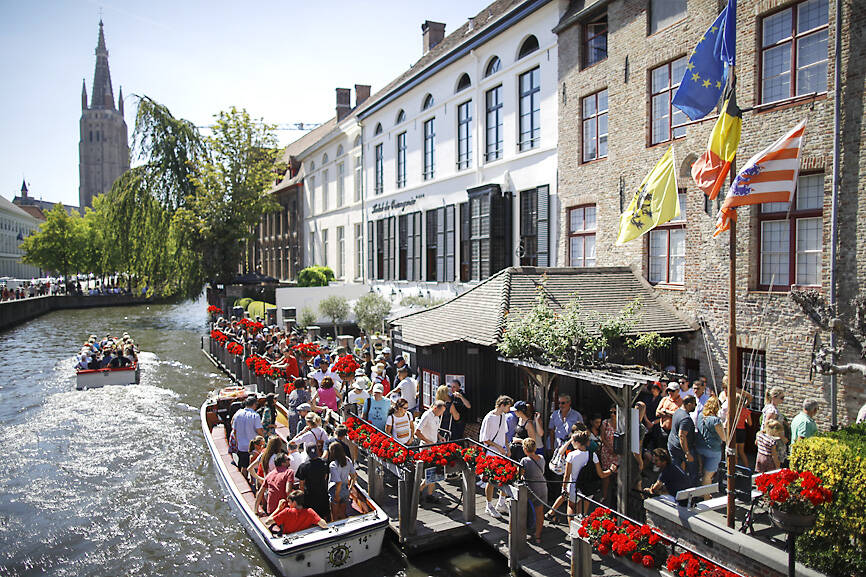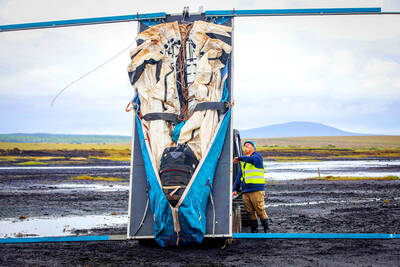Inhabitants of Belgium’s cobblestone-and-canal city of Bruges are clear: Summertime tourism has hit capacity.
“It’s really reached a red line now,” 55-year-old architect Arnout Goegebuer said, as he sat inside a cafe, peering out a window across a packed outside terrace.
“We don’t need more tourists anymore, it’s enough — maybe a little bit less” is needed, he said.

Photo: EPA-EFE
It is a sentiment reiterated by other residents of the western city, population 119,000, which each year hosts 8 million visitors — most of them concentrated in the summer months, and most of them on day trips.
Residents are not against tourism, which brings money and prestige and provides jobs, but they say it needs to be balanced, to stop the city turning into a Disneyfied open-air museum.
With Bruges crowds back to pre-COVID-19 levels, including from cruise ships docking in nearby Zeebrugge port and disgorging passengers who spend just a few hours, “there’s a lot of trouble” for locals, said Kurt Van Der Pieter, a 62-year-old retiree who lived his whole life in the city.
“People of Bruges say it’s too much. It’s too much — very too much some days,” he said.
The situation is not unique to Bruges. Europe’s other top historical canal cities of Venice and Amsterdam have both taken steps to bar cruise ships calling. Venice received a wake-up call last month when UNESCO recommended the city be put on its endangered list because of over-tourism and other problems.
A ranking published in August last year by an Airbnb Inc competitor Holidu put Venice, Bruges and the Greek island of Rhodes in equal second place in its list of the most overcrowded European destinations based on the number of tourists versus inhabitants.
The Croatian walled city of Dubrovnik — famed as the backdrop for much of the Game of Thrones fantasy TV series — ranked first on the list.
Bruges’s tourist authority, Visit Bruges, disputes Holidu’s ranking and says its own figures, based on usage of mobile devices while in Bruges, show 131 daily visitors per 100 inhabitants.
“Bruges is often referred to as a mass tourism destination, but it isn’t,” Visit Bruges spokeswoman Ann Plovie said.
“This is like a bit [of a] misconception that the city is overcrowded. Indeed, I can’t deny that there are many tourists, but you should come on different periods and then you would see also the difference,” another spokeswoman, Anne De Meerleer, said.
In 2019, Bruges implemented a five-year strategy to boost overnight stays, spread the tourist numbers around geographically and over each year, and to lure visitors more interested in cultural and gastronomic deep-dives than selfies and waffles.
“Our aim is to get not more visitors, not the volume is important, but the kind of visitors we get,” De Meerleer said, as she guides a visitor to tourist spots that are almost empty and are just a couple of streets from the main market square.
The results of the strategy are unclear, torpedoed by the 2020-2021 collapse in tourism caused by COVID-19 travel restrictions around the world. Bruges’ city center also faces tensions over accommodation options for overnight stays, with a halt to buildings being converted to hotels to ensure locals are not squeezed out.
Unlike cities such as Milan, Bruges has not banned private vehicles from its historic district, although the railway station is a short walk away. Vehicle registration plates come from all over Europe.
The Belgian city is already at work on its next five-year strategy, this one with an emphasis on sustainability.
The mix of tourists walking around in Bruges is even broader, as is their verdict as to whether they found the place overcrowded or not.
“I didn’t think there would be this much people,” said Lee Hotae, a South Korean tourist admiring the city architecture in a guided group visit.
“It’s not that busy actually. It’s like going to somewhere that’s as nice as Amsterdam or Florence or Venice, but not as overrun,” said a Scottish tourist, Ross Henderson, 43.
A 59-year-old French tourist, Ariele Delattre, who had made the short trip to Bruges from her hometown of Lille, near the Belgian border, said that a canal boat ride revealed the tourist diversity.
The boat’s driver “asked what nationalities were present on the boat, and it’s true that we had Asians, Germans, Britons, French, Indians — people from everywhere,” she said.
Diego Rodriguez, a 41-year-old Venezuelan tourist walking around in a Spanish-speaking guided tour, said he found the tourist numbers “fine like this, especially as we’re in the summer months, the vacation months.”
He added that he had visited Bruges a couple of months earlier “and it was emptier, but it was spring and it was colder, people weren’t on holiday.”

A proposed 100 percent tariff on chip imports announced by US President Donald Trump could shift more of Taiwan’s semiconductor production overseas, a Taiwan Institute of Economic Research (TIER) researcher said yesterday. Trump’s tariff policy will accelerate the global semiconductor industry’s pace to establish roots in the US, leading to higher supply chain costs and ultimately raising prices of consumer electronics and creating uncertainty for future market demand, Arisa Liu (劉佩真) at the institute’s Taiwan Industry Economics Database said in a telephone interview. Trump’s move signals his intention to "restore the glory of the US semiconductor industry," Liu noted, saying that

On Ireland’s blustery western seaboard, researchers are gleefully flying giant kites — not for fun, but in the hope of generating renewable electricity and sparking a “revolution” in wind energy. “We use a kite to capture the wind and a generator at the bottom of it that captures the power,” said Padraic Doherty of Kitepower, the Dutch firm behind the venture. At its test site in operation since September 2023 near the small town of Bangor Erris, the team transports the vast 60-square-meter kite from a hangar across the lunar-like bogland to a generator. The kite is then attached by a

Foxconn Technology Co (鴻準精密), a metal casing supplier owned by Hon Hai Precision Industry Co (鴻海精密), yesterday announced plans to invest US$1 billion in the US over the next decade as part of its business transformation strategy. The Apple Inc supplier said in a statement that its board approved the investment on Thursday, as part of a transformation strategy focused on precision mold development, smart manufacturing, robotics and advanced automation. The strategy would have a strong emphasis on artificial intelligence (AI), the company added. The company said it aims to build a flexible, intelligent production ecosystem to boost competitiveness and sustainability. Foxconn

Leading Taiwanese bicycle brands Giant Manufacturing Co (巨大機械) and Merida Industry Co (美利達工業) on Sunday said that they have adopted measures to mitigate the impact of the tariff policies of US President Donald Trump’s administration. The US announced at the beginning of this month that it would impose a 20 percent tariff on imported goods made in Taiwan, effective on Thursday last week. The tariff would be added to other pre-existing most-favored-nation duties and industry-specific trade remedy levy, which would bring the overall tariff on Taiwan-made bicycles to between 25.5 percent and 31 percent. However, Giant did not seem too perturbed by the